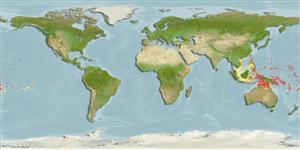>
Eupercaria/misc (Various families in series Eupercaria) >
Labridae (Wrasses) > Xyrichtyinae
Etymology: Novaculops: Latin, novacula = razor + Greek, ops = appearance (Ref. 45335); halsteadi: Named for Robert A. Halstead, who observed the species in Papua New Guinea and suspected it was undescribed..
More on authors: Randall & Lobel.
Environment: milieu / climate zone / depth range / distribution range
Écologie
marin récifal; profondeur 15 - 100 m (Ref. 90102). Tropical
Pacific: Papua New Guinea, Guam, Wake Island, and Tahiti.
Taille / Poids / Âge
Maturity: Lm ? range ? - ? cm
Max length : 12.0 cm SL mâle / non sexé; (Ref. 75958)
Description synthétique
Morphologie | Morphométrie
Épines dorsales (Total): 9; Rayons mous dorsaux (Total): 12; Épines anales 3; Rayons mous anaux: 12; Vertèbres: 25. This species is characterized by the following: D IX,12, the first two dorsal spines flexible and shorter than longest dorsal soft rays; body depth 3.1-3.35 in SL; cheek scaleless; 2 small scales dorsally on opercle; gill rakers 17-20; juveniles and females whitish with a red stripe from above eye to back at base of dorsal fin; males with a pale-edged black spot on seventh lateral-line scale and scales below (Ref. 75958).
Found solitary or in small groups near reefs in sand-rubble bottoms (Ref. 90102). Feeds on small benthic invertebrates (Ref. 89972). Maximum depth reported taken from Ref. 128797.
Life cycle and mating behavior
Maturité | Reproduction | Frai | Œufs | Fécondité | Larves
Oviparous, distinct pairing during breeding (Ref. 205).
Randall, J.E., 2013. Seven new species of labrid fishes (Coris, Iniistius, Macropharyngodon, Novaculops, and Pteragogus) from the Western Indian Ocean. J. Ocean Sci. Found. 7:1-43. (Ref. 93522)
Statut dans la liste rouge de l'IUCN (Ref. 130435)
Menace pour l'homme
Harmless
Utilisations par l'homme
Plus d'informations
Taille/ÂgeCroissanceLongueur-poidsLongueur-longueurFréquences de longueursMorphométrieMorphologieLarvesDynamique des populations larvairesRecrutementAbondanceBRUVS
RéférencesAquacultureProfil d'aquacultureSouchesGénétiqueElectrophoresesHéritabilitéPathologiesTraitementNutrientsMass conversion
CollaborateursImagesStamps, Coins Misc.SonsCiguateraVitesseType de nageSurface branchialeOtolithesCerveauxVision
Outils
Articles particuliers
Télécharger en XML
Sources Internet
Estimates based on models
Preferred temperature (Ref.
123201): 26.5 - 28.8, mean 27.9 °C (based on 72 cells).
Phylogenetic diversity index (Ref.
82804): PD
50 = 0.5156 [Uniqueness, from 0.5 = low to 2.0 = high].
Bayesian length-weight: a=0.01023 (0.00397 - 0.02640), b=3.06 (2.84 - 3.28), in cm total length, based on LWR estimates for this (Sub)family-body shape (Ref.
93245).
Niveau trophique (Ref.
69278): 3.4 ±0.4 se; based on size and trophs of closest relatives
Résilience (Ref.
120179): Haut, temps minimum de doublement de population inférieur à 15 mois (Preliminary K or Fecundity.).
Fishing Vulnerability (Ref.
59153): Low vulnerability (10 of 100).
